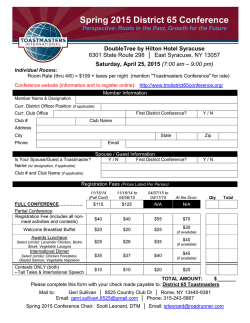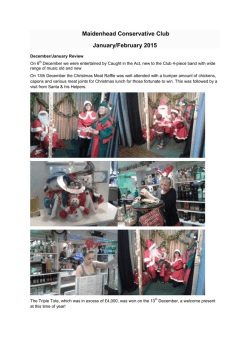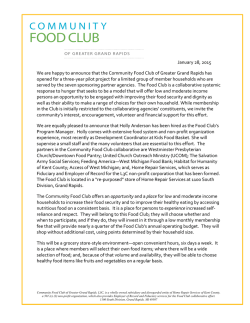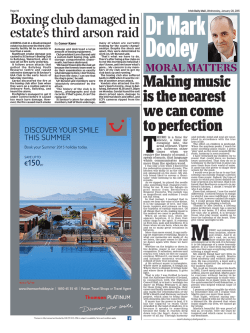
February Issue - Atlanta Astronomy Club
The Focal Point Vol. 27 No. 9 The Atlanta Astronomy Club Established 1947 February 2015 Following his Ph.D. from the University of Georgia--a nationwide look at high school astronomy classes and the effects on them from No Child Left Behind--Dr. Krumenaker has taught astronomy and physics as an adjunct at several different Atlanta colleges, and in Korea and Mexico, as well as continuing his Press. Through Hermograph, he publishes two astronomy education journals for teachers, The Classroom Astronomer, and Journal and Review of Astronomy Education and Outreach, for researchers. Krumenaker is the author of four books, including two in astronomy, and one on the Civil War in Atlanta, Walking the Line, on his rediscovering and documenting of the locations of the 36 forts that defended Atlanta. His talk on Star Trek is material from a forthcoming book called Federation Space, the Real Stars of Star Trek. Table of Contents Page 1... February General Meeting, Membership Renewals Page 2... January Meeting Report & Photos Page 3... January Meeting Photos, Next CEA Meeting Page 4... CEA January Meeting Report, Bradley Obs. Open Houses Page 5... Jeff Goldstein - Astrogizmos, AAC Notes, Countdown to Page 6... Pluto: Encounter - 5 Months Page 7... AAC Online, Memberships, Club Officers & Contact Info Page 8... Calendar, AAC List Serv Info, Focal Point Deadline On March 1st, he begins a stint as Science Journalist in Residence at the Heidelberg Institute for Theoretical Studies in Germany, where he will research and write various print and e-books on astronomy. February General Meeting The Talk Meetings are now on the 2nd Saturday of the month! Where is the United Federation of Planets? Can you find Spock's homeworld? Do you know where the Klingon Empire is, so you can avoid a battle? You can, using the 43 stars and other objects mentioned in the six Star Trek series that are actually real, known in our universe as well as that of the United Federation of Planets. Please join us for the next meeting of the Atlanta Astronomy Club, to be held on Saturday, February 14th at 3PM at the Fernbank Science Center. Since Fernbank closes at 5PM on Saturdays we will now begin our meetings at 3PM. A short beginner’s program will be presented at 2PM. The General Meeting will start at 3PM. Our featured speaker will be Dr. Larry Krumenaker, who will present a talk about the real life stars of Star Trek. After the talk, upcoming club events and programs will be announced by the club officers. Speaker Biography Dr. Larry Krumenaker has been into astronomy since 3rd grade up north in New Jersey. He earned Bachelor and Masters degrees at Case Western Reserve University in Cleveland, where he discovered SS433, the only known microquasar in the Milky Way galaxy. He specializes in stellar spectroscopy of cool and emission-line stars, and historical Mercurian cartography. Since then, Krumenaker has traveled far from Cleveland, having lived in nine states as an astronomy teacher and science journalist. The latter includes stints as science researcher and associate producer with WCBS-AM news, KingWorld productions, and ABC’s 20/20 show, in New York. After numerous freelance articles, including for Sky and Telescope, Science magazine, Odyssey, and many others, plus numerous European publications, he moved to Georgia (for the first time) in 1999, with his own publishing company, Hermograph Press. Editor: Tom Faber Tonight, you will learn about this Federation. Where is this Federation? How about its allies? Its enemies? Where are the borders? And what can you learn about stars and the universe from the objects we could identify? By the time you have traveled through Federation space, you will have learned some astronomy as well, including how we learn about star characteristics, the population of stars in the Milky Way, and galactic structure. The talk will end with information on the Star Trek stars you can identify in the sky tonight. After the program, there will be for sale some mini-posters on the subject of this talk, and some other materials created by the speaker, Dr. Larry Krumenaker. Future Meetings Dates Starting in February the AAC meetings will be on the second Saturday of each month, still at the Fernbank Science Center and at 3PM. The next few meeting dates are: Mar 14, Apr 11, May 9. March is Membership Renewal Month The AAC has moved to a “one-date-for-all” membership renewal. ALL CLUB MEMBERS, with certain exceptions, should submit their $30 dues for 2015 by the end of March. Please send your renewals to AAC Treasurer Sharon Carruthers, renew online using PayPal, or you can bring your renewal to the March Meeting. For more information see: http:// atlantaastronomy.org/?page_id=22 Thank You for your support of the AAC! Page 1 January AAC Meeting Report Meeting photos by Tom Faber The January AAC meeting was held on Saturday, January 17th at the Fernbank Science Center. About 70 members and guests were present. Our scheduled speaker, Anita Westlake, wasn’t able to attend, so Jerry Armstrong presented an interesting and informative talk about comets, asteroids, and meteorites. Jerry explained how they differ, how they are related, and showed a number of photos of these objects. After his talk Jerry showed a number of meteorites from his personal collection and handed out small samples of meteorites found in North Africa to anyone who wanted one. After Jerry’s talk club officers presented information about upcoming club events and activities. Before the main talk AAC president Mark Banks presented the beginners talk. Mark’s talk was about Cosmology & Chemistry, discussing the formation of the chemical elements in stars and supernovae. About 25 people attended Mark’s talk. Photo above: In the foreground are the meteorite samples that Jerry handed out. Behind them are some meteorites from Jerry’s collection including one weighing about 35 pounds (the dark one in the center)! Page 2 Photo above: One of the more unusual meteorites in Jerry’s collection. This is a CAI (calcium-aluminium-rich inclusion) meteorite. CAIs consist of minerals that were some of the first solids to condense in the protoplanetary disk that the solar system formed from. Isotope measurements show that they are at least 4.57 billion years old and possibly older. The Next Charlie Elliott Meeting Join us for our next meeting at 4:00 PM, Saturday, February 21st at the Charlie Elliott Conference Center, Conference Room B. Questions? Contact one of our officers. Meeting Agenda Exoplanets and Open Clusters! Sam Quinn, PhD candidate at Georgia State University, will join us in February to discuss his research involving exoplanets around stars in open clusters. Sam grew up under the dark skies of Vermont, and while astronomy wasn’t his childhood passion, it was always an interest because he was able to walk out on his back porch and see what we see on Jon Wood Astronomy Field and at Deer Lick Astronomy Village. So astronomy seemed a natural fit for his interest in science, math, and physics. Sam began his research in academia his sophomore year, focusing on binary star systems. He eventually wrote his undergraduate thesis on determining orbital properties of exoplanets, which he found are much like extreme mass ratio binary star systems. Sam spent four years continuing his research at the Harvard-Smithsonian Center for Astrophysics supporting NASA’s Kepler mission and later would enroll as a PhD student at Georgia State University in 2011. He is now in his fourth year and his current research involves conducting a radial velocity survey for hot Jupiters in open clusters, with the goal of determining how these short period gas giants migrate so close to their host stars. Planet dynamics strongly shape the characteristics of planetary systems and his research will contribute to our assessment of the likelihood of life elsewhere in the universe. Sam will cover his survey, initial and new discoveries, and how experienced amateur astronomers have the ability to make significant contributions to the field. What’s Up! - Charlie Elliott Astronomy Observing Supervisor John Towne will be giving a short presentation of what you can expect to see in the sky this month with binoculars and small telescopes as well as the monthly Charlie Elliott Observing Challenge. At the meeting, remember to ask John for the target list and SkyMap! The target list and presentation from the last meeting are available for download at the CE Chapter web page. Continued on next page Page 3 Sunset Time Alert - While we would love for everyone to stay for the entire meeting, we realize that some folks prefer to leave a bit earlier so as to set up their equipment at the observing field before dark. If the meeting runs longer than planned, a “Sunset Time Alert” will be announced. Outreach Update - Valorie Whalen & Theo Ramakers “Observing after the Meeting” - All are invited to Jon Wood Astronomy Field immediately after the meeting (weather-permitting). You don’t have to be a member to attend the meeting or join us on Jon Wood Astronomy Field with your telescope (or just your eyeballs). Note: The security gate at the entrance to the main road leading up to the observing field closes at 10:00 p.m. You’ll be able to leave at any time, but you won’t be able to get in after 10:00 p.m. You will, however, be able to park near the gate and walk a few hundred feet to the observing field after 10:00 p.m. At our last meeting/Raffle, the club raised over $750 that will be used to acquire additional material to support out outreach activities! Key outreach events listed below. Note the opportunities to help out! Contact Valorie Whalen for more info… Place: Jon Wood Astronomy Field at Charlie Elliott Wildlife Center. Charlie Elliott Chapter Meeting Report By Van Macatee - CE Chapter Secretary January Meeting of the Charlie Elliott Astronomy Club - January 17, 2015 Steve Siedentop, Chapter Director called the meeting to order. Steve announced a call for volunteers to judge student science projects at the Fulton County Regional Science Fair on Saturday, January 31, 2015 from 9 a.m. to 3 p.m. Contact Mark Banks for more information. Guest Speaker - Elgin Leary, Physics Teacher, Grayson High School Nightfall on Jon Wood Astronomy Field Over 80% of the universe is made up of unknown dark matter and dark energy. The balance is made up of stars of various sizes/ temperatures organized into galaxies and nebula. An informative and insightful talk for sure! After the meeting, we all adjourned to the observing field for a decent night under the stars. After what seemed like months of cloudy weather, it was sure nice to see that all is as it should be in the heavens! John Town, Observing Supervisor John delivered the “What's Up” presentation. This month, the feature constellation is Orion. Jupiter is up all night and Saturn rises early in the morning. There will be a Mars/Neptune conjunction with 0.2 degrees of separation on January 19, 2015 at 6:30 p.m. There will also be a triple shadow transit on Jupiter on January 24, 2015 at 1:35 a.m. The Charlie Elliott Challenge Object for January 2015 is NCG 4236, a barred spiral galaxy in Draco. Attendance: Meeting - 42, Observing Field - 12 telescopes, at least 1 pair of Binoculars and 53 people. January Target List: IC 434 (Horsehead Nebula), M42 (Orion Nebula), Mintaka (Double Star), NGC 2024 (Flame Nebula), M78 (Emission Neb). AL Observing Awards David Whalen - Binocular Double Stars, Marie Lott - Stellar Evolution Next Meeting - February 21, 2015 at 4:00 PM. Guest speaker - Sam Quinn on Exoplanet Formation: Sam Quinn, PhD candidate at Georgia State University, will join us in February to discuss his research involving exoplanets around stars in open clusters. Bradley Observatory Open House Series 2014-2015 Open House Lecture Series for the 2014-2015 school year. The lectures are generally on the second Friday of each month (no open house in January) and run from 8:00PM to 9:00PM. They are followed by viewing with the Observatory’s 30-inch Beck Telescope and smaller telescopes (weather permitting). For updates or possible changes to the schedule of lectures see: http://www.agnesscott.edu/bradleyobservatory/open-houseseries.html Ken Poshedly - Spoke briefly on the benefits of membership in ALPO and made available copies of this months periodical - The Journal of the Association of Lunar & Planetary Observers. February 6: Rosetta Mission - Amy Lovell (Agnes Scott), March 27: Spring Equinox Concert, April 24: Quantum Computing - Adam Meier (GTRI), May 15: Cassini Mission - Carol Paty (Ga Tech) . Page 4 Jeff Goldstein, Owner of Astrogizmos Editor’s Note: The AAC received this very sad news on January 25th. Jeff attended a number of the Peach State Star Gazes. He will be missed... Dear fellow astronomers, It is with a heavy heart and the greatest of sorrow that I must inform you of the passing away at 5 pm this evening of one of our colleagues: Jeff Goldstein, the owner of Astrogizmos. Jeff was an incredibly hard working man and an indefatigable supporter of many astronomical organizations across the country for the past ten years. Unbeknownst to many people, Jeff was a fascinating individual who was accomplished in a wide variety of fields. Besides being an entrepreneur and innovator, Jeff was also a full registered nurse, a computer specialist for Hewlett-Packard with Microsoft Certified Certificates in all aspects of computer science, and had even completed his full Jurist Doctorate of Law and all of this done in what would be much too short a life. He was a generous individual who was always willing to lend anyone a helping hand and I considered him a very close friend. Jeff is survived by wife, Jean; his two sons, Charles and Craig; and (God bless her) his mother, Gladys. I ask all of you to pass the word to others in the astronomical community and ask them to post notices on their club websites. Our star parties, I'm afraid, will be a bit less exciting without him: he will be sorely missed. Jeffrey Norwood CCTS Camera Concepts & Telescope Solutions Countdown to Pluto Encounter - 5 Months 10 South Ocean Ave Patchogue, NY 11772 The PI's Perspective: Something Special in the Air AAC Notes By Alan Stern, New Horizons Principle Investigator, January 23, 2015 The earliest stages of our Pluto encounter have begun, and New Horizons remains healthy and on course. Upcoming DSO Dates and Locations These are the dates for the next few AAC Dark Sky Observing (DSO) events. All of these events are scheduled to be at Grier’s Field at the Deerlick Astronomy Village: February 21, March 21. The locations and dates of the DSOs may change - check the AAC web page for any updates. Asteroid 2004 BL86 Passes the Beehive Check out this cool video of Asteroid 2004 BL86 passing by the Beehive Cluster on the evening of January 26 by club member Daniel Herron! Already, the SWAP, PEPSSI and SDC instruments are taking daily science data — measuring the charged particle and dust environment of the space near Pluto’s orbit. Next week, on Jan. 25, the sensitive LORRI long focal length camera aboard New Horizons will begin imaging the Pluto system for navigation purposes. This will yield dozens of images that our navigation teams will analyze for positional information about Pluto and Charon against star fields, allowing us to home in more accurately than by radio navigation from Earth alone. But while New Horizons approaches the Pluto system ever more closely, there is a little time left to write about what’s in store, so let’s begin. https://www.youtube.com/watch?v=nwQijerjYOQ The Astronomical League As a member of the Atlanta Astronomy Club you are automatically also a member of the Astronomical League, a nation wide affiliation of astronomy clubs. Membership in the AL provides a number of benefits for you. They include: * You will receive The Reflector, the AL’s quarterly newsletter. * You can use the Book Service, through which you can buy astronomyrelated books at a 10% discount. * You can participate in the Astronomical League’s Observing Clubs. The Observing Clubs offer encouragement and certificates of accomplishment for demonstrating observing skills with a variety of instruments and objects. These include the Messier Club, Binocular Messier Club, the Herschel 400 Club, the Deep Sky Binocular Club, and many others. To learn more about the Astronomical League and its benefits for you, visit http://www.astroleague.org In this update, I’m going to preview the atmospheric science we’ll do during the flyby. Next time, I’ll preview the surface geology and composition measurements we’re planning. But first I want to give you the basics of what we know about Pluto’s atmosphere, and Charon’s. Pluto’s atmosphere is composed primarily of nitrogen, just like Earth’s atmosphere. But its minor gases aren’t oxygen and argon – as on Earth – they are carbon monoxide and methane; other gases may also be present. Pluto’s atmospheric pressure is about the same as that in the Earth’s mesosphere, about 30 to 50 miles above the ground. Its atmosphere is known to display a mild greenhouse effect, as well as winds and, very likely, some hazes. There may even be clouds. We also know that Pluto’s atmosphere is rapidly escaping, much like the way the early Earth’s atmosphere escaped, in a process called hydrodynamic escape. This happens when molecules high in the atmosphere are hot enough to simply flow away, a little like a cup of water filled up from the bottom and brimming over the rim. Page 5 Continued on next page As for Charon: it’s been speculated that this world, Pluto’s largest moon may, have an atmosphere. Perhaps it was captured (siphoned) off Pluto or created by internal activity or a recent cometary impact. But whatever (if anything) is there, it’s been too thin to find from Earth. New Horizons will attempt to do better. Our objectives for atmospheric science during the flyby match the recommendations from the scientific advisory committees that worked with NASA to conceive a Pluto flyby mission; they include: atmosphere as a function of height over the surface. We’ll also perform the same experiment at Charon to determine if it has a thin atmosphere and what that envelope may be made of. (REX will try to do the same, but it’s not as sensitive as Alice for detecting atmospheres as thin as Charon’s is likely to be.) PEPSSI, which stands for Pluto Energetic Particle Spectrometer Science Investigation, measures high-energy ions that originate in Pluto’s atmosphere and accelerate as they stream away in the solar wind. PEPSSI will determine the composition as well as the densities of these ions; this will help us pin down Pluto’s atmospheric composition and escape rate. * Determine how Pluto’s atmospheric pressure and temperature vary from the surface to high altitude. * Determine the atmosphere’s complete composition. * Measure the atmospheric escape rate. * Determine if Pluto has an ionosphere. * Determine how Pluto’s atmosphere varies from place to place, and with seasons and time of day. * Search for an atmosphere at Charon. That’s a long and ambitious list of objectives, and we’re carrying a very capable suite of scientific instruments to probe all of these questions. Here’s a brief preview of the atmospheric science we’re planning for later this year, organized by instrument: REX is our radio science experiment. On closest-approach day — July 14 — REX will intercept a set of four 20-kilowatt beams of radio energy sent to Pluto by giant 70-meter-wide antennas in NASA’s Deep Space Network. By measuring how these radio beams refract (or bend) through Pluto’s atmosphere, REX can help us determine the base pressure and temperature of Pluto’s atmosphere, as well as how those quantities vary with altitude above Pluto’s surface. REX can also determine another atmospheric quantity: the density of ionospheric layers high over Pluto. Alice is our ultraviolet spectrometer. Many of the gases in Pluto’s atmosphere reveal themselves best at ultraviolet wavelengths. We’ll be using Alice over several weeks as we approach Pluto to search for emissions that reveal certain atomic gases like hydrogen, oxygen, nitrogen and argon in Pluto’s upper atmosphere. Then, on encounter day, we’ll fly into Pluto’s shadow and watch the Sun rise and set with Alice to The Alice ultraviolet spectrometer determine the composition of the aboard New Horizons. (Image: atoms and molecules in Pluto’s NASA/JHUAPL) (Image: NASA/JHUAPL/SwRI/Dan Durda/Magda Saina) SWAP, for Solar Wind Around Pluto, performs a clever measurement of Pluto’s total atmospheric escape rate. How? At some distance from Pluto, the atmospheric escape pressure balances with the incoming solar wind pressure – and the distance at which this occurs from Pluto reveals the rate of Pluto’s atmospheric escape. SWAP’s job is to accurately measure that distance by determining where the solar wind cuts off and Pluto’s atmosphere begins. LORRI (our Long Range Reconnaissance Imager) and Ralph are primarily surface imagers – not atmospheric instruments – but they can shed light on Pluto’s atmosphere by searching for clouds and hazes, both as New Horizons approaches and recedes. In fact, LORRI and Ralph could, in principle, make the first atmospheric detections of Pluto by New Horizons by capturing images of just such phenomena, perhaps even weeks before REX, Alice, PEPSSI and SWAP conduct their investigations. As you can see, we have a wide variety of ways to plumb Pluto’s atmosphere and search for one around Charon. The fun begins in May, and intensifies across June and July. Stay tuned – soon I won’t be talking about plans, I’ll be able to write about results! As I close, I know you know that this is our last January before reaching our long-sought objective of reconnoitering Pluto and its system of moons. But what you may not know is that January is a very special month for the New Horizons team: We launched in January, our science team meets to plan ahead every January, and January is also when Clyde Tombaugh took the images of Gemini that initiated his discovery of Pluto. So hail to January, and also to this July when our explorations culminate — just around the bend! That’s it for now, but until I write again, I hope you’ll keep exploring— just as we do. Page 6 Atlanta Astronomy Club Online While this newsletter is the official information source for the Atlanta Astronomy Club, it is only up to date the day it is printed. So if you want more up to date information, go to our club’s website. The website contains pictures, directions, membership applications, events updates and other information. http://www.atlantaastronomy.org You can also follow the AAC on Facebook by joining the AAC group, and on Twitter at http:// twitter.com/atlastro. AAC Officers and Contacts President: Mark Banks [email protected] Program Chair: Richard Jakiel [email protected] Hubble Spies a Loopy Galaxy Observing Chair: Daniel Herron [email protected] NASA/STScI News Release - January 29, 2015 Corresponding Secretary: Tom Faber [email protected] This NASA Hubble Space Telescope photo of NGC 7714 presents an especially striking view of the galaxy’s smoke-ring-like structure. The golden loop is made of Sun-like stars that have been pulled deep into space, far from the galaxy’s center. The galaxy is located approximately 100 million light-years from Earth in the direction of the constellation Pisces. Treasurer: Sharon Carruthers [email protected] Recording Secretary: Alan Coffelt, [email protected] Board Chair: Sharon Carruthers [email protected] The universe is full of such galaxies that are gravitationally stretched and pulled and otherwise distorted in gravitational tug-o’-wars with bypassing galaxies. The companion galaxy doing the “taffy pulling” in this case, NGC 7715, lies just out of the field of view in this image. A very faint bridge of stars extends to the unseen companion. The close encounter has compressed interstellar gas to trigger bursts of star formation seen in bright blue arcs extending around NGC 7714’s center. Board: Brigitte Fessele, Contact info TBA Board: David Lumpkin, Contact info TBA Board: Steve Phillips [email protected] ALCor: Jamie Anderson, [email protected] Elliott Chapter Director: Steve Siedentop [email protected] Elliott Observing Supervisor: John Towne [email protected] The gravitational disruption of NGC 7714 began between 100 million and 200 million years ago, at the epoch when dinosaurs ruled the Earth. Elliott Recording Secretary: Van Macatee [email protected] The image was taken with the Wide Field Camera 3 and the Advanced Camera for Surveys in October 2011. Elliott Coordinator: Alesia Rast [email protected] Elliott Webmaster: Theo Ramakers 770-666-5084 [email protected] Credit: NASA and ESA Acknowledgment: A. Gal-Yam (Weizmann Institute of Science) Elliott Outreach Coordinator: Jack Fitzmier [email protected] The Atlanta Astronomy Club, Inc., one of the South’s largest and oldest astronomical society, meets at 3:00 P.M. on the 2nd Saturday of each month at the Fernbank Scince Center in Decatur, or occasionally at other locations or times. Membership fees are $30 for a family or single person membership. College Students membership fee is $15. These fees are for a one year membership. Georgia Astronomy in State Parks: Sharon Carruthers [email protected] PSSG Chairman: Peter Macumber [email protected] PSSG Co-Chair: Open Sidewalk Astronomy: Brad Isley [email protected] Magazine subscriptions to Sky & Telescope or Astronomy can be purchased through the club for a reduced rate. The fees are $33 for Sky & Telescope and $34 for Astronomy. Renewal forms will be sent to you by the magazines. Send the renewal form along with your check to the Atlanta Astronomy Club treasurer. Light Tresspass: Ken Edwards, Contact info TBA Woodruff Observ. Coordinator: Sharon Carruthers [email protected] AAC Webmaster: Daniel Herron The Club address: Atlanta Astronomy Club, Inc., P.O. Box 76155, Atlanta, GA 30358-1155. AAC Web Page: http:// www.AtlantaAstronomy.org. Send suggestions, comments, or ideas about the website to [email protected]. Also send information on upcoming observing events, meetings, and other events to the webmaster. [email protected] Page 7 On Twitter at http://twitter.com/atlastro www.atlantaastronomy.org Atlanta, GA 30358-1155 P.O. Box 76155 Atlanta Astronomy Club We’re here to help! Here’s how how to reach us: Alpharetta, GA 30022 FROM: Newsletter of The Atlanta Astronomy Club, Inc. The Focal Point www.beetagg.com Tom Faber FIRST CLASS 2206 Treeridge Parkway Please send articles, pictures, and drawings in electronic format on anything astronomy, space, or sky related to Tom Faber at [email protected]. Please send images separate from articles, not embedded in them. Articles are preferred as plain text files but Word documents or PDF’s are okay. You can submit articles anytime up to the deadline. The deadline for March is Saturday, February 21. Submissions after the deadline will go in the following issue. Focal Point Deadline and Submission Information Subscribe to the Atlanta Astronomy Club Mailing List: The name of the list is: AstroAtlanta. The address for messages is: [email protected] . To add a subscription, send a message to: [email protected] . Atlanta Astronomy Club Listserv For more event listings see the calendar at www.atlantaastronomy.org Apr 25th, Saturday: Moon First Quarter. Apr 18th, Saturday: New Moon. CEA Meeting. Apr 11th, Saturday: Moon Last Quarter. AAC Meeting at Fernbank Science Center 3:00PM. Apr 4th, Saturday: Full Moon. Mar 27th, Friday: Moon First Quarter. Mar 22nd, Sunday: Moon near Venus. Mar 21st, Saturday: Moon near Mars. DSO at DAV, CEA Meeting. Mar 20th, Friday: New Moon. Spring Equinox at 6:45PM EDT. Mar 14th, Saturday: AAC Meeting at Fernbank Science Center 3:00PM. Mar 13th, Friday: Moon Last Quarter. Mar 12th, Thursday: Moon near Saturn. Mar 8th, Sunday: Daylight-Saving Time starts at 2:00AM. Mar 5th, Thursday: Full Moon. Mar 2nd, Monday: Moon near Jupiter. Feb 26th, Thursday: Neptune conjunction with Sun. Mercury Greatest Elongation West. Feb 25th, Wednesday: Moon First Quarter. Feb 21st, Saturday: DSO at DAV, CEA Meeting at 4:00PM. Conjunction Venus and Mars. Feb 20th, Friday: Close grouping of Moon, Venus, and Mars. Feb 18th, Wednesday: New Moon. Feb 14th, Saturday: AAC Meeting at Fernbank Science Center 3:00PM. Feb 11th, Wednesday: Moon Last Quarter. Feb 6th, Friday: Jupiter at Opposition. Feb 3rd, Tuesday: Full Moon. AAC Events are listed in BOLD Calendar by Tom Faber (Times EDT/EST unless noted)
© Copyright 2026







